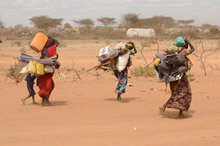
Typical street scene in Santa Ana, El Salvador. (Photo: iStock)
IMF Survey: IMF in Talks on Financing Boost for Drought-hit Africa
August 24, 2011
- IMF discusses extra resources for Djibouti, Kenya through existing loans
- New concessional loans can be quickly made available if requested
- Scope seen for work to increase effectiveness of disaster-relief assistance
The IMF, welcoming international support for drought-hit countries in the Horn of Africa, is discussing with Djibouti and Kenya increasing existing loans to the two East African countries as part of the response.

Refugees in Dadaab, Kenya: some 800,000 refugees have fled drought in Somalia to go to Ethiopia, Kenya, Djibouti (photo: Boris Roessler/DPA)
HORN OF AFRICA DROUGHT
In an interview, IMF African Department Director Antoinette Sayeh said that there is also room to boost disaster-relief aid effectiveness.
Sayeh was speaking ahead of an August 25 pledging conference in Addis Ababa, Ethiopia, convened by the African Union to raise financing for drought relief in East Africa. In a separate statement, IMF Managing Director Christine Lagarde welcomed support from the international community that has been pledged so far in a twin-track approach to provide immediate relief and ensure food security in the long term.
IMF Survey online: What is the impact of the drought on the countries in the Horn of Africa?
Sayeh: The Horn of Africa is undergoing its worst drought in some 60 years. In the case of Somalia, the World Food Program, for example, has concluded that the famine there is a catastrophe. We have some 800,000 refugees who have fled Somalia to go to Ethiopia, Kenya, and Djibouti. Food prices in the region as a whole have increased significantly, creating severe hardship for people both in rural and urban areas.
And on the economic front we have seen increased inflation across the subregion. In Kenya and Tanzania inflation is now in double digits, around 13–14 percent, as a result of significantly increased food prices.
In relation to import bills, because of the dependence of this region on hydropower for electricity, many countries are seeing shortages in power and are forced then to import fuel to facilitate generation of power. In addition to that, we expect some negative impact on overall growth because of the adverse consequences for agriculture.
Let me also underscore the significant pressures upon the budgets of countries in the region, because they are forced to make available emergency food supplies, which are only partly covered by international aid being provided in response to the drought.
IMF Survey online: You’ve described a very dire situation. What can the international community do, and especially the IMF, to help those countries?
Sayeh: The Fund will work in the context of a broader international coordinated effort. First and foremost, disaster relief is the priority. The World Food Program has made an appeal for some $2.4 billion in financing for disaster relief to help with the famine. Unfortunately, much of that amount is still outstanding and has not been raised.
So the priority is really to get some support for this effort and to have this financing in place. And in that context we’re hopeful that the forthcoming August 25 pledging conference convened by the African Union in Addis Ababa will be successful and that we’ll see some rallying around this request.
In the case of the Fund, we have to work in our areas of a mandate. We’re not a disaster relief institution. On the other hand, it’s clear that affected countries are going to have a significant balance of payments financing need. In that context, the Fund can work very quickly to make available concessional loans.
We are, in fact, working already with Kenya and discussing with Kenya and Djibouti raising additional resources in the context of existing loans that are already in place for those countries. For other countries we can also quickly put together new loans if they make a request for Fund assistance.
In addition to financing there’s an opportunity for us to work to increase the effectiveness of aid in support of disaster relief. We can also, through our public financial management technical assistance, help countries better target their support on those who really need help.
The Fund, unfortunately, is not able to provide much support to Somalia given the absence of a recognized government in Somalia. But through our support to other countries that are now hosts to large numbers of Somalian refugees we can certainly help to provide relief.
IMF Survey online: So in the future, what policies should countries follow in the event of similar disasters?
Sayeh: In the last 10 to 15 years or so the frequency of intense droughts has increased, and so it is absolutely important to mitigate the impact of droughts so that we protect sustained economic growth in these countries. And this is not an area of the Fund’s expertise, but certainly we think that there are things that countries can do on the economic policy front to mitigate the impact of droughts. One of them is to actually remove barriers to trade and to facilitate trade under those circumstances. And certainly it’s not a wise thing in that context to have export bans, which there are temptations sometimes to put in place.
Countries can also work to minimize a very significant dependence on hydropower in East Africa. That is, of course, disrupted when you have a drought, and in that context you have to then start to import significant amounts of fuel, which is very expensive. So to the extent that countries are able to develop more geothermal sources of power, as Kenya is now trying to do, they have an opportunity to really mitigate the impact of a severe drought on power supply and, through that, on broad economic activity.


